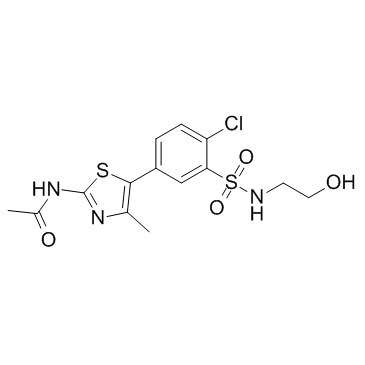593960-11-3
| Name | N-[5-[4-chloro-3-(2-hydroxyethylsulfamoyl)phenyl]-4-methyl-1,3-thiazol-2-yl]acetamide |
|---|---|
| Synonyms |
N-(5-(4-CHLORO-3-(2-HYDROXY-ETHYLSULFAMOYL)-PHENYLTHIAZOLE-2-YL)-ACETAMIDE
PIK93 S1489_Selleck Acetamide, N-[5-[4-chloro-3-[[(2-hydroxyethyl)amino]sulfonyl]phenyl]-4-methyl-2-thiazolyl]- N-(5-{4-Chloro-3-[(2-hydroxyethyl)sulfamoyl]phenyl}-4-methyl-1,3-thiazol-2-yl)acetamide 2chz N-(5-(4-Chloro-3-(N-(2-hydroxyethyl)sulfamoyl)phenyl)-4-methylthiazol-2-yl)acetamide PIK-93 |
| Description | PIK-93 is the first potent, synthetic PI4K (PI4KIIIβ) inhibitor with IC50 of 19 nM, and also inhibits PI3Kγ and PI3Kα with IC50 of 16 nM and 39 nM, respectively. |
|---|---|
| Related Catalog | |
| Target |
PI4KIIIβ:19 nM (IC50) PI4KIIIα:1.1 μM (IC50) p110γ:16 nM (IC50) p110α:39 nM (IC50) p110δ:120 nM (IC50) p110β:590 nM (IC50) PI3KC2β:140 nM (IC50) PI3KC2α:16 μM (IC50) hsVPS34:320 nM (IC50) DNA-PK:64 nM (IC50) ATM:490 nM (IC50) mTORC1:1.38 μM (IC50) ATR:17 μM (IC50) |
| In Vitro | PIK-93 inhibits PI3Kγ and PI4KIIIβ, with IC50 values of 16 nM and 19 nM, respectively. PIK-93 also inhibits other members of PI3Ks, including PI3Kα, β, and δ, with IC50 values of 39 nM, 0.59 μM, and 0.12 μM, respectively. PIK-93 shows no obvious inhibitory effect against a panel of other kinases, even at a concentration of 10 μM[1]. In differentiated HL60 (dHL60) cells, PIK-93 (0.5 μM-1 μM) impairs consolidation and stability of the leading edge formed after treatment with uniform f-Met-Leu-Phe (fMLP). PIK-93 alters the localization, but not the amount, of the fMLP-dependent accumulation of total F-actin. In fMLP gradients, PIK-93 reduces the chemotactic index and triples the cells' turning frequency[2]. In COS-7 cells, PIK-93 (250 nM) effectively abrogates the accumulation of CERT-PH domain and FL-Cer in Golgi. PIK-93 of the same concentration also significantly inhibits the conversion of [3H]serine-labeled endogenous ceramide to sphingomyelin. These facts indicate a key role of PI4KIIIβ in ceramide transport between the ER and Golgi, as well as in the regulation of spingomyelin synthesis[3]. In T6.11 cells, PIK-93 (300 nM) reduces carbachol-induced translocation of TRPC6 to the plasma membrane and net Ca2+ entry[4]. A recent report shows that PIK-93 has anti-enterovirus effects, as revealed by its inhibition of both poliovirus (PV) and hepatitis C virus (HCV) replication, with EC50 values of 0.14 µM and 1.9 µM, respectively[5]. |
| Kinase Assay | IC50 values are measured using a standard TLC assay for lipid kinase activity. Kinase reactions are performed by preparing areaction mixture containing kinase, PIK-93 (2% DMSO final concentration), buffer (25 mM HEPES, pH 7.4, 10 mM MgCl2), and freshly sonicated phosphatidylinositol (100 µg/mL). Reactions are initiated by the addition of ATP containing 10 µCi of γ-32P-ATP to a final concentration 10 or 100 µM, and allowed to proceed for 20 min at room temperature. For TLC analysis, reactions are then terminated by the addition of 105 µL 1N HCl followed by 160 µL CHCl3:MeOH (1:1). The biphasic mixture is vortexed, briefly centrifuged, and the organic phase transferred to a new tube using a gel loading pipette tip precoated with CHCl3. This extract is spotted on TLC plates and developed for 3 hours-4 hours in a 65:35 solution of n-propanol:1M acetic acid. The TLC plates are then dried, exposed to a phosphorimager screen, and quantitated. Kinase activity is typically measured at 10-12 concentrations of PIK-93 representing two-fold dilutions from the highest concentration of 100 μM. |
| Cell Assay | For actin staining, dHL60 cells are preincubated in suspension with PIK-93 or vehicle for 40 min, centrifuged for 5 min at 2000 rpm at room temperature in a J6-B centrifuge, resuspended in mHBSS containing the respective agent at the same concentration, allowed to stick to fibronectin-covered coverslips, and subjected to stimulation with a uniform concentration of 100 nM f-Met-Leu-Phe (fMLP) for 3 min. Cells are fixed in 3.7% PFA and stained with 10 units/mL rhodamine-phalloidin for 15 min. |
| References |
| Density | 1.48 g/cm3 |
|---|---|
| Boiling Point | 611.8ºC at 760 mmHg |
| Molecular Formula | C14H16ClN3O4S2 |
| Molecular Weight | 389.87800 |
| Flash Point | 323.8ºC |
| Exact Mass | 389.02700 |
| PSA | 148.50000 |
| LogP | 4.12210 |
| Appearance | white to beige |
| Storage condition | 2-8°C |
| Water Solubility | DMSO: soluble15mg/mL, clear |
| RIDADR | NONH for all modes of transport |
|---|
